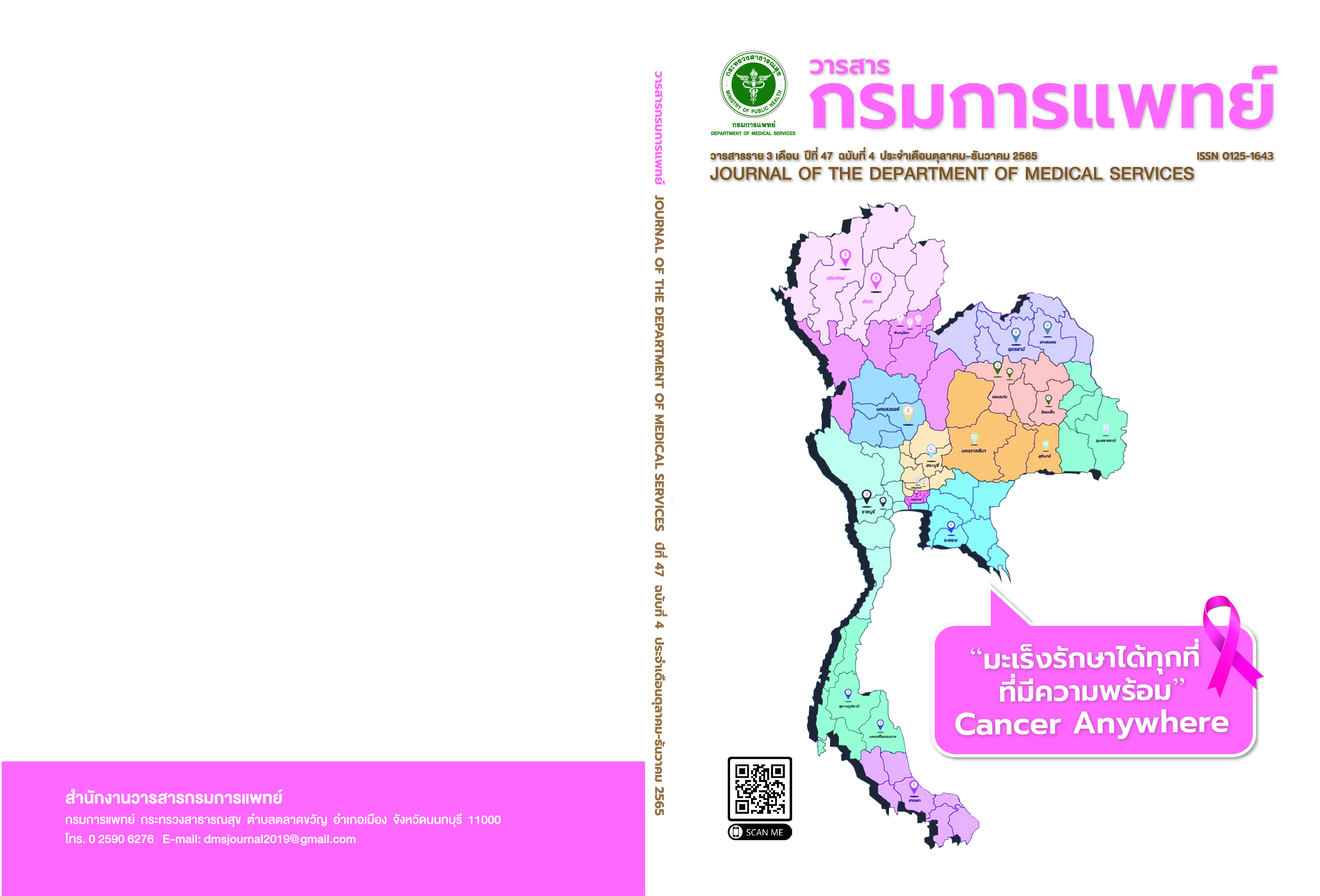Factors Associated with the Success of Initial Non-surgical Root Canal Treatment Performed by Dental Postgraduates
Keywords:
success, factors associated, root canal treatmentAbstract
Background: The study of the success of root canal treatment is important for prognostication and decisionmaking for treatment planning. However, the study of the success rate and factors associated with initial non-surgicalroot canal treatment performed by dental postgraduates at the Institute of Dentistry have never been evaluated. Objective: The aim of this research was to evaluate the success and factors associated with initial non-surgical rootcanal treatment performed by dental postgraduates at the Institute of Dentistry, Ministry of Public Health, from2016 to 2020. Method: A retrospective study was done by collecting data from treatment and radiographic records.Radiographs obtained at pre-operation and the follow-up periods were collected following the Periapical index.The treatment outcome was evaluated to be a success or a failure based on the clinical and radiographic criteria.Factors associated with the treatment were analyzed using chi-square and multiple logistic regression. Result: Therecall rate was 65.2%, ranging from 6 to 52 months, The success rate was 81.7%, the failure rate was 18.3%, and thefunctional rate was 96.6%. The factor significantly associated with initial non-surgical root canal treatment was thepre-operative periapical lesion, in which teeth without any pre-operative periapical lesion had a chance of successmore than teeth with pre-operative periapical lesion < 5 mm and ≥ 5 mm, with the odds ratio of 0.07 and 0.37,respectively. Conclusion: The success rate of initial non-surgical root canal treatment was 81.7% and the failure ratewas 18.3%. The pre-operative periapical lesion was significantly associated with the success of initial non-surgicalroot canal treatment.
References
Azim AA, Griggs JA, Huang GT. The Tennessee study: factorsaffecting treatment outcome and healing time followingnonsurgical root canal treatment. Int Endod J. 2016; 49:6-16.
de Chevigny C, Dao TT, Basrani BR, Marquis V, Farzaneh M,Abitbol S, et al. Treatment outcome in endodontics: the Torontostudy--phase 4: initial treatment. J Endod. 2008; 34:258-63.
Sjogren U, Hagglund B, Sundqvist G, Wing K. Factors Affecting theLong-term Results of endodontic treatment. J Endod. 1990; 16:498-624.
Friedman S, Mor C. The success of endodontic therapy-healing andfunctionality. CDAjournal. 2004; 32:493-503.
Ng YL, Mann V, Rahbaran S, Lewsey J, Gulabivala K. Outcome ofprimary root canal treatment: systematic review of the literature -- Part2. Influence of clinical factors. Int Endod J. 2008; 41:6-31.
Pirani C, Chersoni S, Montebugnoli L, Prati C. Long-term outcomeof non-surgical root canal treatment: a retrospective analysis.Odontology. 2015; 103:185-93.
Friedman S. Prognosis of initial endodontic therapy. EndodonticTopiccs. 2002; 2:59-88.
Friedman S, Abitbol S, Lawrence HP. Treatment outcome in endodontics: the Toronto Study. Phase 1: initial treatment. J Endod. 2003;29:787-93.
Imura N, Pinheiro ET, Gomes BP, Zaia AA, Ferraz CC, SouzaFilho FJ. The outcome of endodontic treatment: a retrospective studyof 2000 cases performed by a specialist. J Endod. 2007; 33:1278-82.
Orstavik D, Kerekes K, Eriksen HM. The periapical index: A scoringsystem for radiographic assessment of apical periodontitis. EndodDent Traumatol. 1986; 2:20-34.
Sivavetpikul P, Wisithphrom K, Puapichartdumrong P. Theoutcome of endodontic treatment performed by dentalstudents : A retrospective study. CU Dent J. 2019; 42:39-52.
Atmeh A, Al-Hadi Hamasha A. Outcome assessment of nonsurgical root canal treatment by patients: what factors can influencetheir evaluation? Br Dent J. 2020; 228:762-6.
Vire DE. Failure of endodontically treated teeth : classifcation andevaluation. Journal of Endodontics. 1991; 17:338-42.
Ørstavik D, Qvist V, Stoltze K. A multivariate analysis of theoutcome of endodontic treatment. Eur J Oral sci. 2004; 112:224-30.
Peng L, Ye L, Tan H, Zhou X. Outcome of root canal obturation by warm gutta-percha versus cold lateral condensation: ameta-analysis. J Endod. 2007; 33:106-9.
Pontoriero DIK, Grandini S, Spagnuolo G, Discepoli N,Benedicenti S, Maccagnola V, et al. Clinical Outcomes ofEndodontic Treatments and Restorations with and withoutPosts Up to 18 Years. J Clin Med. 2021; 10:1-12.
Kerekes K, Tronstad K. long trem results of endodontictreatment performed with a standardized technique. Journal ofEndodontics. 1979; 5:83-90.
Craveiro MA, Fontana CE, de Martin AS, Bueno CE. Influence of coronalrestoration and root canal flling quality on periapical status: clinicaland radiographic evaluation. J Endod. 2015; 41:836-40.
Komabayashi T, Colmenar D, Cvach N, Bhat A, Primus C, Imai Y.Comprehensive review of current endodontic sealers. Dent Mater J.2020; 39:703-20.
Huumonen S, Orstavik D. Radiographic follow-up of periapical statusafter endodontic treatment of teeth with and without apical periodontitis. Clin Oral Investig. 2013; 17:2099-104.
Simsek-Kaya G, Saruhan N, Yapici-Yavuz G, Ertas U. A decision analysisfor periapical surgery: Retrospective Study. J Clin Exp Dent. 2018;10:e914-e20.
Smith CS, Setchell DJ, Harty FJ. Factors influencing the success ofconventional root canal therapy-a fve year retrospective study. IntEndod J. 1993; 26:321-33.
Downloads
Published
How to Cite
Issue
Section
License
Copyright (c) 2022 Department of Medical Services, Ministry of Public Health

This work is licensed under a Creative Commons Attribution-NonCommercial-NoDerivatives 4.0 International License.
บทความที่ได้รับการตีพิมพ์เป็นลิขสิทธิ์ของกรมการแพทย์ กระทรวงสาธารณสุข
ข้อความและข้อคิดเห็นต่างๆ เป็นของผู้เขียนบทความ ไม่ใช่ความเห็นของกองบรรณาธิการหรือของวารสารกรมการแพทย์



